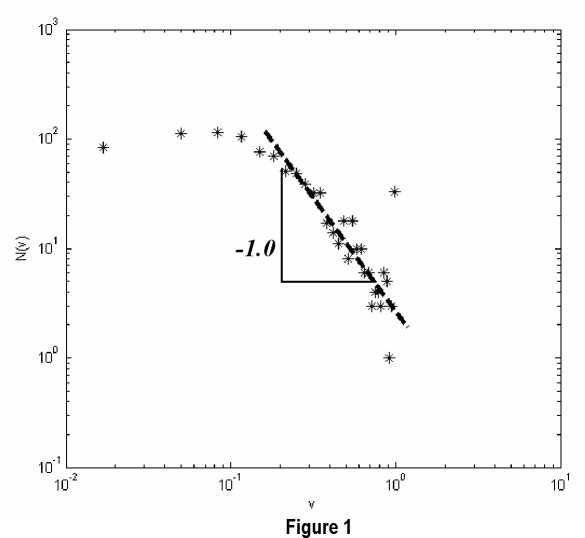and so on up to many pre-election processes, while the average votes gained by candidate
in n-th subprocess is
fn(c)=c1c2...cn (4)
The total votes gained by candidates are then can be assumed as the multiplicative
process since the total votes gained by candidate eventually in the election after large
amount of n is
v= fn(c)=c1c2...cn
(5)
While v denotes the total votes for candidates in the ballot, and N(v) as the number of
candidates that received the fraction votes v, we can have the histogram of N(v) vs v as
the statistical distribution of the whole voting process. This explanation was also
proposed by Filho, et. al. (2002) on finding the power-law characteristic in Brazilian
election.
It is very interesting that the histogram resulted (N(v) vs v) is not a gaussian one but a
power-law characters showing that the election result is somehow a self-organized and
critical social conditions. For the election of the member of Regional Representative
Council (DPD: Dewan Perwakilan Daerah) that elected for the first time in 2004, the
distribution of the number of candidates N receiving fraction of votes v followed a
power-law N(v) ~ vα with fitted α≈ 1 . This fact can be seen in figure 1.

The double-log histogram of the result of DPD (Regional Representative Council) 2004 election.
In the other hand, the result of election for House of Representatives is also power-law
but with approximated exponent lower than 1. The signature of the power-law
distribution is not only seen in the result of 2004 election but also in the previous (1999)
More intriguing information
1. Work Rich, Time Poor? Time-Use of Women and Men in Ireland2. Expectation Formation and Endogenous Fluctuations in Aggregate Demand
3. Gianluigi Zenti, President, Academia Barilla SpA - The Changing Consumer: Demanding but Predictable
4. Existentialism: a Philosophy of Hope or Despair?
5. Higher education funding reforms in England: the distributional effects and the shifting balance of costs
6. The name is absent
7. AMINO ACIDS SEQUENCE ANALYSIS ON COLLAGEN
8. Proceedings of the Fourth International Workshop on Epigenetic Robotics
9. fMRI Investigation of Cortical and Subcortical Networks in the Learning of Abstract and Effector-Specific Representations of Motor Sequences
10. Fiscal Reform and Monetary Union in West Africa